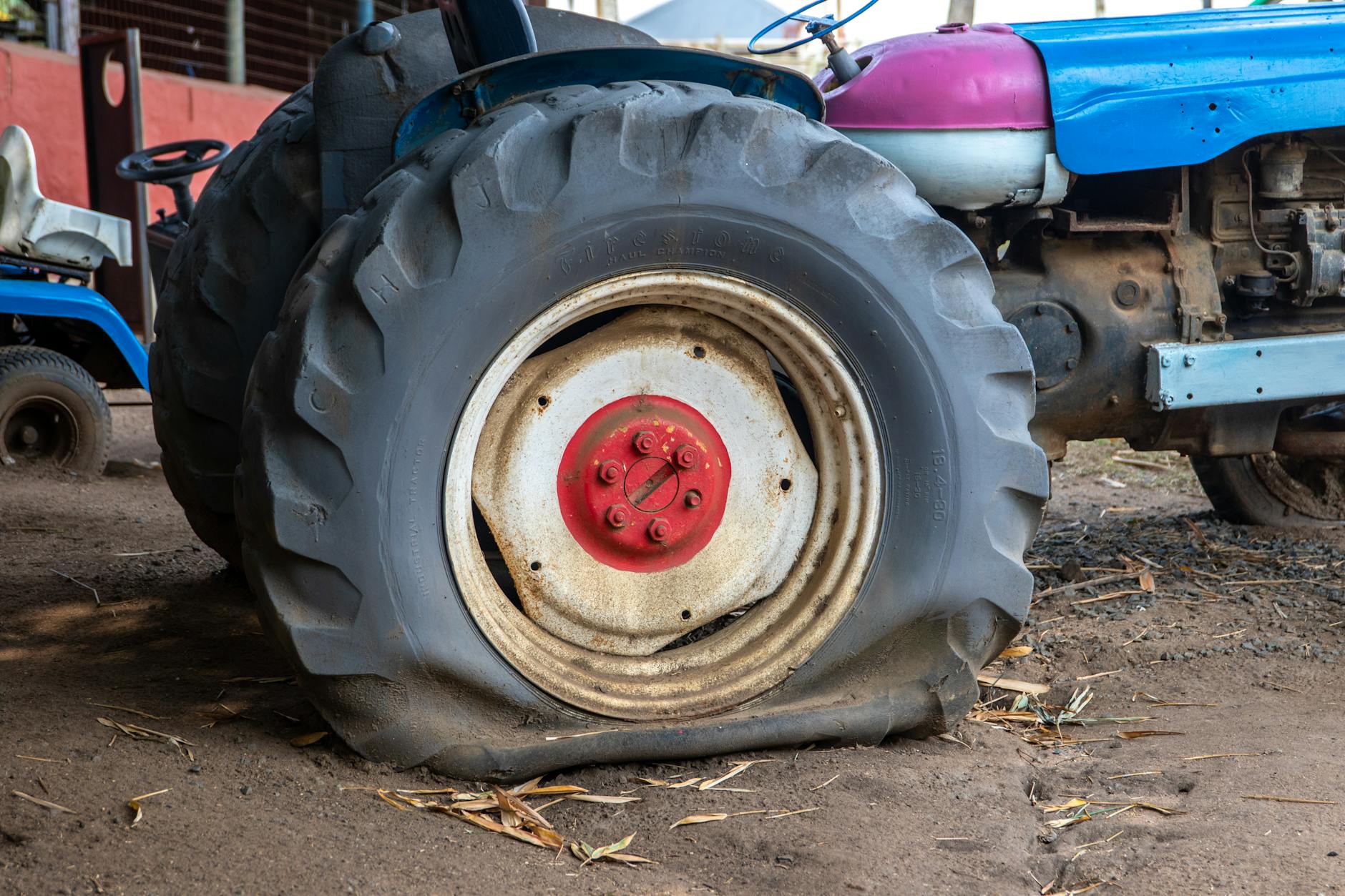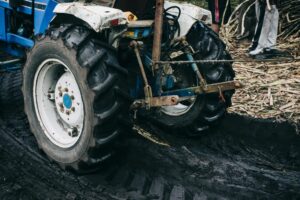Filling tractor tyres with water is a common practice to increase traction, lower the center of gravity, and improve stability in farming operations. This process, known as liquid ballasting, is especially useful for heavy-duty fieldwork, plowing, and loader operations.
In this guide, we’ll cover:
✅ Benefits of filling tractor tyres with water
✅ Step-by-step instructions for adding water ballast
✅ Best liquids to use (water, calcium chloride, antifreeze, etc.)
✅ Safety tips and precautions.
How to Fill Tractor Tyres with Water
1. Why Fill Tractor Tyres with Water?
Filling tractor tyres with liquid provides extra weight to improve performance.
🚜 Key Benefits:
✔️ Increases traction – Reduces wheel slippage in wet or loose soil
✔️ Improves stability – Lowers the center of gravity, reducing tipping risk
✔️ Enhances fuel efficiency – Less slippage means better power transfer
✔️ Balances weight distribution – Ideal for tractors with front loaders
🔹 When to Use Water Ballast?
✅ Heavy plowing or pulling equipment
✅ Working on wet, muddy, or sandy soil
✅ Preventing wheel spin during fieldwork
✅ When extra weight is needed without using wheel weights
🚫 When NOT to Use Water Ballast: ❌ When driving long distances on roads (reduces fuel efficiency) ❌ In freezing temperatures (unless mixed with antifreeze)
2. Best Liquids for Tractor Tyre Ballasting
🔹 Choosing the Right Liquid:
Liquid Type Freezing Point Pros Cons
Water0°C (32°F)Cheap, easy to use Freezes in winter
Calcium Chloride (CaCl2) Solution-50°C (-58°F)Heavy (adds more weight), inexpensive Can cause rust if spilled
Antifreeze (Ethylene or Propylene Glycol)-30°C (-22°F)Prevents freezing Expensive, toxic (ethylene glycol)
Windshield Washer Fluid-20°C (-4°F)Cheap, easy to find Less dense than CaCl2
Beet Juice (Rim Guard™)-35°C (-31°F)Non-toxic, rust-proof, heavier than water Expensive
Methanol/Alcohol Mix-40°C (-40°F)Cheap, prevents freezing Highly flammable
🔹 Recommended for Cold Climates:
- Calcium chloride solution (CaCl2) – Most cost-effective and adds more weight.
- Beet juice (Rim Guard™) – Best for preventing rust but expensive.
- Antifreeze mixture – Works well but can be toxic if spilled.
🔹 Recommended for Warm Climates:
- Plain water (cheapest option).
3. How to Fill Tractor Tyres with Water (Step-by-Step Guide)
🛠️ Tools & Equipment Needed:
✔️ Water hose ✔️ Tyre valve adapter (air/water fill adapter) ✔️ Pump (optional, for faster filling) ✔️ Bucket (for mixing antifreeze or calcium chloride) ✔️ Jack (to lift tractor if needed)
🚜 Step 1: Position the Tractor Properly
- Park the tractor on level ground.
- Set the parking brake.
- Rotate the tyre valve to the top (12 o’clock position).
🚰 Step 2: Remove the Valve Core
- Use a valve core removal tool to take out the core.
- This allows air and water to move freely in and out.
💦 Step 3: Attach the Water Fill Adapter
- Connect the air/water fill adapter to the tyre valve.
- Attach a hose to the adapter.
🌊 Step 4: Fill the Tyre with Water
- Slowly start filling the tyre.
- Fill up to 75–80% of the tyre volume (leaving an air pocket for expansion).
- Use a pump for faster filling.
🫧 Step 5: Release Air Bubbles Periodically
- Stop every few minutes and let air escape from the tyre.
- This prevents air pockets inside the tyre.
❄️ Step 6: Add Antifreeze (If Needed)
- If using calcium chloride, dissolve it in a bucket of water first (1 kg per 4 liters of water).
- If using antifreeze, mix with water before pouring it in.
🔄 Step 7: Reinstall the Valve Core & Inflate the Tyre
- Remove the hose and adapter.
- Reinstall the valve core.
- Inflate the tyre to the recommended air pressure (check tractor manual).
✅ Done! Your tractor tyres are now water-filled for better traction.
4. Safety & Maintenance Tips
✔️ Avoid Overfilling
- Keep the water level at 75–80% capacity to leave room for air.
✔️ Prevent Freezing in Cold Climates
- Always add antifreeze (calcium chloride, windshield washer fluid, or beet juice) in freezing regions.
✔️ Check for Leaks & Rust
- Calcium chloride can cause rust if spilled. Check the rims regularly.
- If using CaCl2, apply a rust-proofing sealant inside the wheel rim.
✔️ Adjust Air Pressure When Needed
- Liquid ballast reduces air capacity, so check and adjust pressure as needed.
✔️ Remove Water Before Long Road Travel
- Water ballast increases rolling resistance, reducing fuel efficiency on paved roads.
5. Frequently Asked Questions (FAQs)
❓ How much weight does water add to a tractor tyre?
- 1 gallon of water weighs 8.34 lbs (3.78 kg).
- For a large rear tyre, water ballast can add 300–1,000 lbs (136–454 kg) per tyre.
❓ Can I use salt water to prevent freezing?
- No. Saltwater is highly corrosive and can damage rims and valves.
- Use calcium chloride or antifreeze instead.
❓ How do I remove water from tractor tyres?
- Rotate the valve to the bottom (6 o’clock position).
- Use a siphon pump or gravity drain.
- Once most of the liquid is out, inflate the tyre with air to force out any remaining water.
Final Thoughts: Is Water Ballasting Right for You?
✅ Use Water Ballast If: ✔️ You need extra traction for plowing, pulling, or loader work. ✔️ Your tractor struggles with wheel spin in wet or loose soil. ✔️ You want a cost-effective way to improve stability.
🚫 Avoid Water Ballast If: ❌ You drive long distances on roads frequently. ❌ You work in extremely cold climates (unless using antifreeze). ❌ You need fast tyre inflation adjustments.
By choosing the right liquid, following the correct filling procedure, and maintaining your tyres properly, you can enhance your tractor’s performance and extend tyre life.
👉 Have more questions? Drop a comment below!



